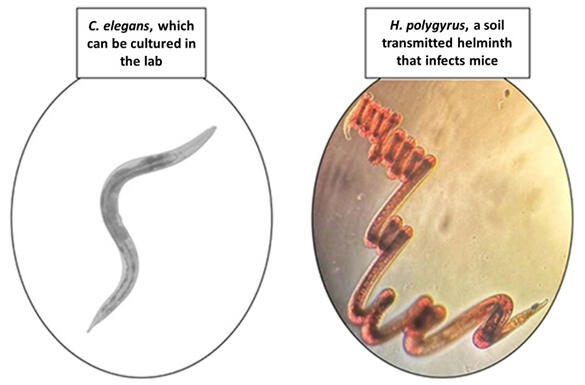A research group led by Unit Leader Hiroyuki Osada, (also the Unit Leader of the Drug Discovery Chemical Bank Unit), and Nobumoto Watanabe, a temporary employee, of the Chemical Resource Development Research Unit at the RIKEN Center for Sustainable Resource Science, in collaboration with Professor Andrew Fraser of the Donnelly Centre at the University of Toronto in Canada, and the Swiss Tropical and Public Health Institute, has announced the discovery of candidate compounds that exert anthelmintic effects against soil-transmitted helminths (STHs) via a novel mechanism of action. These compounds were discovered by searching the RIKEN Natural Product Library using a high-throughput Caenorhabditis elegans anaerobic condition movement assay developed at the University of Toronto. The findings are expected to contribute to developing new anthelmintics against STHs, which infect more than one billion people worldwide. The results were published in the international academic journal Nature Communications on May 8.

Provided by RIKEN
STHs are a type of intestinal parasitic worm that spreads through the ingestion of plants or water contaminated with parasite eggs from the feces of infected humans or animals, or through larvae penetration of the skin. Effective anthelmintics are scarce, and resistant strains to the few available anthelmintics are increasing. As a result, there is an urgent need for the development of new anthelmintics.
After infecting a host, STHs become parasitic in the host's intestine and use the mitochondrial electron transport chain, which is not present in the host animals, in a specialized way to adapt to the hypoxic environment. Under these conditions, electrons are transferred using the pathway to complex II with rhodoquinone (RQ), similar to ubiquinone used under hyperoxia. Therefore, inhibitors of this pathway are considered capable of killing STHs without affecting the host. Since this pathway is also present in the model organism C. elegans, Fraser and his colleagues used it to develop a system to search for RQ pathway-specific inhibitors.
When C. elegans is exposed to potassium cyanide, it stops its activity as in hypoxic conditions, but it remains alive through the RQ pathway and recovers the activity once the potassium cyanide is removed. However, in the presence of an RQ pathway inhibitor, C. elegans cannot survive and is killed. Fraser and his colleagues have also developed a system to screen many compounds instantly and quantitatively. In this study, this method was used to search 400 representative compounds from the RIKEN Natural Product Library "NPDepo." They succeeded in discovering candidate compounds. Furthermore, they searched for analogs of these compounds and obtained compounds with higher activity.
Analysis of the mechanism of action revealed that these compounds inhibited complex I in the mitochondrial electron transport chain of C. elegans. Analysis of the effects of the four most active compounds on STH parasitizing mice showed that they killed up to 40% of the STH in mice, although they could not completely cure the disease.
Watanabe said, "I am very pleased that we could find candidate compounds for a new type of anthelmintics from the RIKEN Natural Product Library using a new C. elegans-based searching method. This method can be applied to search for anthelmintic candidates with a different mechanism of action, and we hope to continue our search for future commercialization."
Journal Information
Publication: Nature Communications
Title: Identification of a family of species-selective complex I inhibitors as potential anthelmintics
DOI: 10.1038/s41467-024-47331-3
This article has been translated by JST with permission from The Science News Ltd. (https://sci-news.co.jp/). Unauthorized reproduction of the article and photographs is prohibited.




